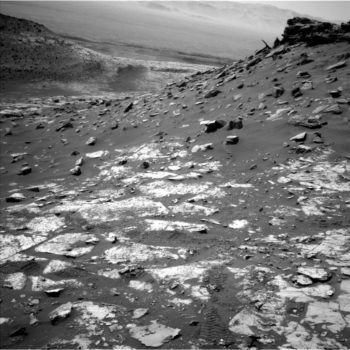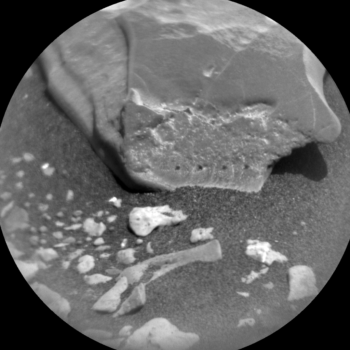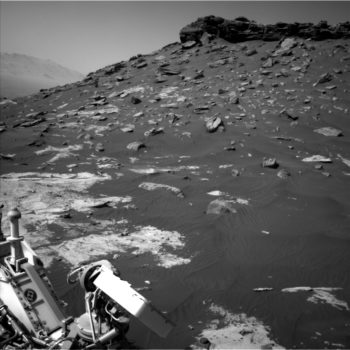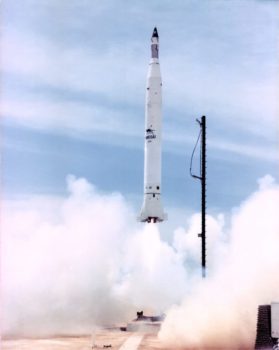Archive for January, 2020

Curiosity Front Hazard Avoidance Left B Camera image taken on Sol 2661, January 31, 2020.
Credit: NASA/JPL-Caltech
NASA’s Curiosity Mars rover is now performing Sol 2661 duties.
Curiosity’s recent drive successfully moved uphill and closer to the “Greenheugh” pediment, reports Michelle Minitti, a planetary geologist at Framework in Silver Spring, Maryland.
“The rocks around us were a riot of shapes, colors and textures, making it difficult to limit ourselves to which ones we would look at,” Minitti adds. “The team is trying to understand how (or if) the bedrock chemistry changes as we move closer to the Greenheugh pediment, as the pediment marks a change in rock type from the majority of rocks we have encountered through the clay-bearing “Glen Torridon” unit.”

Curiosity Left B Navigation Camera photo acquired on Sol 2661, January 31, 2020.
Credit: NASA/JPL-Caltech
As such, many of the rover targets are dedicated to the bedrock.

Curiosity Left B Navigation Camera photo acquired on Sol 2661, January 31, 2020.
Credit: NASA/JPL-Caltech
Free of veins
The robot’s Mars Hand Lens Imager (MAHLI) and its Alpha Particle X-Ray Spectrometer (APXS) are slated to analyze “Cullivoe” and “Bogmill Pow,” the former after it has been brushed by the Dust Removal Tool (DRT).
“Cullivoe represents the flatter, smoother areas of the bedrock free of veins or other erosion-resistant features while Bogmill Pow is one of the rough, multicolored areas of the bedrock,” Minitti points out.

Curiosity Mars Hand Lens Imager (MAHLI) photo produced on Sol 2660, January 30, 2020 shows results of Dust Removal Tool.
Credit: NASA/JPL-Caltech/MSSS
Curiosity’s Chemistry and Camera (ChemCam ) is to analyze a similarly complementary pair of targets.
The goal is for “High Possil” to represent the background bedrock in this area, while “Duncairn” specifically focuses on an erosion-resistant feature that appears to be emerging from its host bedrock.
Spectacular feature
“Veins were a particularly spectacular feature of the workspace, often exhibiting white interiors and thin, gray exteriors,” Minitti explains. The most notable example is the bright, linear feature given the name “Tilicoultry,” with a gray slab broken off and sitting on the sand to the right of the vein, named “Hastigrow.”
“This pair, and the bedrock and sand surrounding them,” Minitti says, “will be imaged using the Mastcam multispectral technique, which ought to help uncover the differences among the bedrock and the parts of the vein.”
Higher elevations call
Curiosity will intersperse observations of the sky among all those of the ground.
Mastcam will acquire early morning images to measure the dust load in the atmosphere, and Navcam will acquire late afternoon movies to look for clouds and dust devils.

Curiosity Left B Navigation Camera photo acquired on Sol 2661, January 31, 2020.
Credit: NASA/JPL-Caltech
Radiation Assessment Detector (RAD) and Rover Environmental Monitoring Station (REMS) maintain their steady watch of the weather and radiation environment in Gale, and the Dynamic Albedo of Neutrons (DAN) will seek signals of hydrogen from under the rover both before and after the rover’s drive.
“Yes, as hard as it will be to leave this spot, higher elevations call! We will drive to the highest accessible bedrock exposure just below the pediment in hopes that we can interrogate its chemistry over the weekend,” Minitti concludes. “Surely, more excitement awaits!”
Southern Launch is an Adelaide-based space company and is moving ahead to develop the world’s largest privately operated rocket test range near Koonibba, in the far west of South Australia.
Australia’s Koonibba Test Range will extend out over uninhabited national park, and is located on Aboriginal land north-west of Ceduna. The site provides the ability to recover rockets and do further testing and systems validation. The test site is on the land of the Koonibba Aboriginal community of roughly 200 people.
Trial location
The Koonibba test range will be used as a trial location for companies before launching rockets into orbit from the Whalers Way Orbital Launch Complex near Port Lincoln.
Southern Launch is aiming to have a demonstration launch as soon as possible, according to the group’s website. This launch would not orbit a payload but prove that once again that Australia can launch rockets.
History
Australia was the 4th country in the world to successfully launch a satellite into space with the WRESAT satellite in 1967 and the Prospero satellite in 1971.
Both were launched from Woomera in South Australia. Australia has not launched anything into orbit from its soil since then.
For more information on Southern Launch, go to:
The European Space Agency is studying multiple techniques for 3D printing of structures on the Moon, including solar sintering and ceramics.
A 1.5 ton hollow cell block made from simulated lunar dust has been produced using a binding salt as “ink.”
The structure was made during an initial feasibility project on lunar 3D printing. It is on display in the laboratory corridor of ESA’s European Space Research and Technology Center (ESTEC) in the Netherlands.
ESTEC is the European Space Agency’s main technology development and test center for spacecraft and space technology.

These finely-detailed ceramic parts have been 3D printed using simulated lunar regolith as part of an ESA-led investigation into how 3D printing could be used to support a lunar base.
Credit: ESA–G. Porter, CC BY-SA 3.0 IGO
Moon settlement
In an earlier ESA statement it was noted that work was underway in designing an advanced printer that could complete an entire building in a week.
3D printing works best at room temperature but over much of the Moon temperatures vary enormously across days and nights lasting two weeks each.

Mosaic of the lunar south pole from images acquired by ESA’s Small Missions for Advanced Research in Technology (SMART-1) that flew 2003-2006.
Credit: ESA
3D printing works best at room temperature but over much of the Moon temperatures vary enormously across days and nights lasting two weeks each. For potential settlement, the lunar poles offer the most moderate temperature range.
The Shackleton area at the south pole of the Moon comes with an illuminated peak located 4.3 miles (7 kilometers) from the Shackleton rim. This “Peak of almost Eternal Light” could be used to supply electricity via solar panels to a future base.

Curiosity Front Hazard Avoidance Camera Right B image taken on Sol 2659, January 29, 2020. The rover is analyzing the bedrock target “Lost Valley.”
Credit: NASA/JPL-Caltech
NASA’s Curiosity Mars rover is wrapping up Sol 2659 tasks.
Curiosity is heading for the bench reports Catherine O’Connell, a planetary geologist at University of New Brunswick Fredericton in New Brunswick, Canada.

Curiosity Left B Navigation Camera image taken on Sol 2659, January 29, 2020.
Credit: NASA/JPL-Caltech
“The bench is an area that we are very interested in,” O’Connell explains, “as it marks a potential contact between the mudstones and sandstones that we have been driving over and a ‘capping’ rock, which looks quite different.”
As the robot drives, O’Connell adds, Mars researchers are looking for changes in chemistry and sedimentary processes, which can help them understand one of the big questions they are wrestling with right now: “Why are these buttes here?!!”

Curiosity Left B Navigation Camera image taken on Sol 2659, January 29, 2020.
Credit: NASA/JPL-Caltech
Bedrock targets
On the plan, a short science block using the rover’s Chemistry and Camera (ChemCam) and its Mastcam, as well as contact science with the Alpha Particle X-Ray Spectrometer (APXS) and use of the Mars Hand Lens Imager (MAHLI). Following is a drive towards the bench along the side of
“Tower Butte.”
APXS and MAHLI are analyzing the bedrock target “Lost Valley,” whilst ChemCam and Mastcam are analyzing two other bedrock targets “Balantyre” and “Aberdeenshire.”

Curiosity Left B Navigation Camera image taken on Sol 2659, January 29, 2020.
Credit: NASA/JPL-Caltech
Up the hill
“Mastcam will also image a very intriguing rock, “Hill of Stake” outside of the range of the other instruments, and further imaging of the “Greenheugh” pediment, which we hope to climb onto before this year is out,” O’Connell says.

Curiosity Left B Navigation Camera image taken on Sol 2659, January 29, 2020.
Credit: NASA/JPL-Caltech
“Once these activities are complete,” O’Connell continues, “we start to climb further up the hill towards Tower Butte, hoping to end up with more bedrock in our workspace for a more complete compositional picture.”
Environmental activities
The environmental theme group (ENV) crammed activities into the short sol too, including “full tau” and “crater rim” observations, which allows the ENV group to quantify dust in the crater and overhead in the atmosphere.

Curiosity Mars Hand Lens Imager photo produced on Sol 2659, January 29, 2020.
Credit: NASA/JPL-Caltech/MSSS
Rover Environmental Monitoring Station (REMS) is slated to acquire temperature, pressure, humidity, and UV radiation measurements.
The robot’s Dynamic Albedo of Neutrons (DAN) experiment continues its search for subsurface hydrogen, with frequent passive (utilizing cosmic rays as a source of neutrons to measure hydrogen) and also taking post-drive active (actively shooting neutrons from the rover) measurements, O’Connell concludes.

Artist’s view of the James Webb Space Telescope (JWST) in space, up and operating tackling a full agenda of space science conquests.
Credit: Northrop Grumman
The James Webb Space Telescope (JWST) is the planned successor to the Hubble Telescope. Costs for the project have already increased by 95% and the launch date has been delayed by more than 6.5 years.
A new Government Accountability Office (GAO) report flags the fact that technical challenges have caused schedule strain and may increase costs. For JWST there is little margin for error and there are challenges with integration and test work ahead.
Rescheduled launch date
Technical issues with certain JWST components in 2019 have made it unfeasible for the project to launch by its goal of November 2020. Instead, the project is working towards its official rescheduled launch date of March 2021. But a recent cost and schedule analysis for JWST that GAO recommended in its last report, found the project unlikely to meet this date.
The GAO report notes that the JWST project has made significant progress since its last report in March 2019, such as completing testing of the observatory’s individual elements and integrating them together in August 2019.

JWST’s combined science instruments and optical element recently completed 100 days of thermal vacuum testing inside NASA Johnson Space Center’s Chamber A. Engineers are seen by the hardware shortly after it emerged from the huge test facility on December 1, 2017.
Credit: NASA/Chris Gunn
New technical challenges
“However, new technical challenges have required the project to use more schedule reserve—extra time set aside in the project’s schedule to accommodate unforeseen risks or delays—than planned.”
As of October 2019, the JWST project had used about 76 percent of its available schedule reserve and no longer plans to launch in November 2020. The project is now managing to a March 2021 launch date but estimates only 12 percent likelihood that this date will be achieved.
NASA plans to reassess the launch date in the spring of 2020.
For more information on this GAO document — JAMES WEBB SPACE TELESCOPE: Technical Challenges Have Caused Schedule Strain and May Increase Costs go to:
https://www.gao.gov/assets/710/704078.pdf
A hightlights overview of the report can be read at:

Curiosity Right Navigation Camera Right B image taken on Sol 2658, January 28, 2020.
Credit: NASA/JPL-Caltech

Curiosity Chemistry & Camera Remote Micro Imager (RMI) photo taken on Sol 2658, January 28, 2020.
Credit: NASA/JPL-Caltech/LANL

Curiosity Front Hazard Avoidance Camera Left B image acquired on Sol 2658, January 28, 2020.
Credit: NASA/JPL-Caltech

Curiosity Navigation Camera Left B photo taken on Sol 2658, January 28, 2020.
Credit: NASA/JPL-Caltech

Curiosity Navigation Camera Left B photo taken on Sol 2658, January 28, 2020.
Credit: NASA/JPL-Caltech

Curiosity Navigation Camera Left B photo taken on Sol 2658, January 28, 2020.
Credit: NASA/JPL-Caltech

Curiosity Navigation Camera Left B photo taken on Sol 2658, January 28, 2020.
Credit: NASA/JPL-Caltech
NASA’s Curiosity Mars rover has just begun Sol 2659 operations.
Reports Ken Herkenhoff, a planetary geologist at USGS Astrogeology Science Center in Flagstaff, Arizona, a Sol 2657 drive by the rover went well, “so we have new bedrock exposures to explore on Sol 2658.”
The goal is to get good chemical and remote sensing data in this location before proceeding uphill toward the south.
A “touch-and-go” sol is planned, starting with a short Alpha Particle X-Ray Spectrometer (APXS) integration on a bedrock slab named “Marchmont.”
The rover’s Mars Hand Lens Imager (MAHLI) is slated to take some images of Marchmont, and then the arm will be moved out of the way for Chemistry and Camera (ChemCam) observations of Marchmont and “Inverness Shire,” a darker block sitting on the bedrock surface.
Curiosity’s Right Mastcam is scheduled to then take images of the ChemCam targets and “Whitelaw Moss,” another slab of bedrock.
Mastcam will also acquire a 13×3 stereo mosaic of the west side of Tower Butte to examine its sedimentary structures.
Herkenhoff explains that after a rover drive of 75 feet (23-meters) and the usual post-drive activities, ChemCam will use Autonomous Exploration for Gathering Increased Science (AEGIS) to automatically select a bedrock target in the rover’s new location.
Finally, the robot’s Mars Descent Imager (MARDI) is scheduled to take an image during twilight.

Curiosity Front Hazard Avoidance Camera Left B image acquired on Sol 2657, January 27, 2020.
Credit: NASA/JPL-Caltech
NASA’s Curiosity Mars rover is now carrying out Sol 2658 tasks.

Curiosity Left B Navigation Camera photo taken on Sol 2657, January 27, 2020.
Credit: NASA/JPL-Caltech
“Curiosity continues to function normally on Mars. We are at a very interesting point with potential changes in rock chemistry,” reports Susanne Schwenzer, a planetary geologist at The Open University, Milton Keynes, United Kingdom.
“That always gets the geochemists like me to sit up and pay extra attention. But we don’t always get it our way, because other investigations are just as important,” Schwenzer adds.
Engineering judgements

Curiosity Left B Navigation Camera photo taken on Sol 2657, January 27, 2020.
Credit: NASA/JPL-Caltech
A recent two-sol plan with the third day being a soliday, did not make it any easier as scientists awaited Curiosity engineering judgements on the rover’s overall power – and the power available was not enough to get it all done.
“In a case like this, careful considerations are required regarding what observations are specific to the location or the time, and which ones could wait for the next plan,” Schwenzer explains.
For one, the environmental group gave up an observation to make it all fit, but retains the crater rim extinction and the full tau observation.
Bedrock: two different types
“From a geochemist’s perspective the most interesting part of the story at the current location is that we see two different types of bedrock. One is characterized in the images by a smoother appearance and veins in it. This type is the primary focus on the plan. But there is nodular bedrock, too,” Schwenzer explains.

Curiosity Left B Navigation Camera photo taken on Sol 2657, January 27, 2020.
Credit: NASA/JPL-Caltech
The robot’s Alpha Particle X-Ray Spectrometer (APXS) has the smoother bedrock in reach and will measure the target “Rannoch Moore” as an evening investigation and “Sauchiehall” as an overnight, long duration target after use of the Dust Removal Tool (DRT).
In the plan, Curiosity’s Mars Hand Lens Imager (MAHLI) was to document both targets.
Chemistry and Camera ( ChemCam) will investigate “Rannoch Moore” in conjunction with APXS, and has the targets “Janetstown,” also on smoother bedrock, and “Glenalmond” on the nodular version, Schwenzer points out.

Curiosity Left B Navigation Camera photo taken on Sol 2657, January 27, 2020.
Credit: NASA/JPL-Caltech
Excellent view
“At our current location, we have an excellent view of several buttes and the Geenheugh pediment. This is reflected in a very busy plan for Mastcam. The Greenheugh pediment and Tower Butte are images together in a 19×4 mosaic, but there are two more observations with mosaics on Western Butte and the trough feature in front of us,” Schwenzer says. “This will allow for detailed analysis of the sediments, but also aid the upcoming drives. Exciting times at a very interesting location!”

Curiosity Mars Hand Lens Imager photo produced on Sol 2657, January 27, 2020.
Credit: NASA/JPL-Caltech/MSSS
Regarding the rover’s environmental sensor activity, a sunset tau, and Mars Descent Imager (MARDI), Dynamic Albedo of Neutrons (DAN) and Rover Environmental Monitoring Station (REMS) measurements as well as post-drive imaging complete this very busy plan.
In addition to all the observations, Schwenzer notes that Curiosity is set to drive 164 feet (50 meters)…uphill! “I am sure Curiosity is happy and ready for a recharging soliday after this plan!”
The Contact Paradox – Challenging our Assumptions in the Search for Extraterrestrial Intelligence by Keith Cooper, Bloomsbury Publishing; 2020; Hardback; 336 pages, $28.00.
Space journalist Keith Cooper takes on a set of assumptions regarding the on-going and perplexing search for other starfolk.
This is a well-written, well-researched, and a must read that spotlights the saga of SETI, how it has evolved over the decades and what outcomes may be looming in the future. More importantly, the reader will find this book challenging suppositions…and grappling with the ramifications if SETI succeeds.
In eight chapters, Cooper takes on such heady topics as the altruism assumption, messages from Earth, technosignatures, 21st century SETI, and possible societal consequences of contact.
The author writes: “SETI is not just a search for aliens. It’s also a search for ourselves. We project out hopes and fears, our history and our expectations about the future of humanity onto what we think extraterrestrial civilizations might be like.”
Cooper offers the reader a balance of thought-provoking views and opinions, not only his own, but tapping into the thoughts of leading figures in SETI and related fields.
Taking into account the escalating number of exoplanets being discovered – yet we remain faced with silence from the stars — you’ll find an absorbing, first-rate read in The Contact Paradox.
This book also includes a glossary and a healthy resource of further reading suggestions tied to each chapter.
For more information on this book, go to:
https://www.bloomsbury.com/us/the-contact-paradox-9781472960429/

Curiosity Front Hazard Avoidance Left B Camera image taken on Sol 2655, January 24, 2020.
Credit: NASA/JPL-Caltech
NASA’s Curiosity Mars rover is wrapping up Sol 2655 tasks.
Here’s a selection of new imagery taken by the robot:

Curiosity Front Hazard Avoidance Left B Camera image taken on Sol 2655, January 25, 2020.
Credit: NASA/JPL-Caltech

Curiosity Left B Navigation Camera photo taken on Sol 2655, January 25, 2020.
Credit: NASA/JPL-Caltech

Curiosity Left Navigation Camera image acquired on Sol 2654, January 24, 2020.
Credit: NASA/JPL-Caltech

Curiosity Left Navigation Camera image acquired on Sol 2654, January 24, 2020.
Credit: NASA/JPL-Caltech

Curiosity Left Navigation Camera image acquired on Sol 2654, January 24, 2020.
Credit: NASA/JPL-Caltech

Curiosity Chemistry & Camera Remote Micro-Imaging (RMI) photo taken on Sol 2655, January 25, 2020.
Credit: NASA/JPL-Caltech/LANL
Road map
Meanwhile, A new map shows the route driven by NASA’s Mars rover Curiosity through the 2654 Martian day, or sol, of the rover’s mission on Mars (January 24, 2020).
Numbering of the dots along the line indicate the sol number of each drive. North is up.
From Sol 2645 to Sol 2654, Curiosity had driven a straight line distance of about 128.88 feet (39.28 meters).
Since touching down in Bradbury Landing in August 2012, Curiosity has driven 13.54 miles (21.79 kilometers).
The base image from the map is from the High Resolution Imaging Science Experiment Camera (HiRISE) in NASA’s Mars Reconnaissance Orbiter.

DLR sample carrier containing bacteria and fungi during its nine-hour journey into the stratosphere.
Credit: NASA
Late last year, astrobiologists let loose a “zoo” of microorganisms that traveled by high altitude stratospheric balloon for nine hours – a journey up to 19 miles (30 kilometers) above the Earth.
At this altitude, the shielding effects of Earth’s atmosphere are greatly reduced, and the temperature, radiation and pressure are akin to the conditions found on Mars.
The astrobiologists were from the German Aerospace Center (Deutsches Zentrum für Luft- und Raumfahrt), the DLR.
The DLR scientists took part in a NASA program called “Microbes in Atmosphere for Radiation, Survival and Biological Outcomes Experiment” or MARSBOx for short.
Preliminary findings
The results of that September 2019 trip are under analysis by a DLR team. The preliminary biological findings are now available.
“These show that most of the bacteria have been killed, with the strong ultraviolet radiation proving to be particularly problematic for them,” points out a DLR statement on the MARSBOx flight. Only a few staphylococci – human pathogens – survived the journey. In contrast, mould spores survived better under the extreme conditions in the stratosphere.
Some of the organisms underwent testing outside the protective troposphere for the very first time.
Survival properties
Ralf Möller, a microbiologist at the DLR Institute of Aerospace Medicine in Cologne, explains: “In order to proliferate, moulds form spores that are highly resistant to extreme conditions such as dryness and radiation. In addition, fungi have very efficient protective mechanisms against radiation, such as strong black pigmentation and effective DNA repair.”
Although many bacteria have properties that are similar to this, Möller adds that the mould spores are much more resistant to the extreme Martian conditions than the bacteria that the DLR team tested.
“The results demonstrate how important it is to continue with research into microorganisms,” Möller says, “particularly fungi, and their survival properties in space, not least in the interests of the health of astronauts on long-term missions to space stations and, later, to habitats on the Moon and Mars.”
Major test campaign
Bacteria and fungi are part of nature and human life. Whether they live on the outside of our bodies – on our skin – or inside us,
Many species of bacteria and fungi are harmless. Some are even useful. On the other hand, there are also varieties that can be dangerous to humans and cause serious diseases. These pose invisible dangers to space travelers on space stations or on future journeys to outposts situated on other worlds, such as Mars.
Issues of “planetary protection” must also be considered. If landers, rovers or other space vehicles carrying bacteria or fungi set down on planets and celestial bodies, they could contaminate the surface.
Investigations into microorganisms under space conditions are ongoing.
For example, as early as summer 2020, samples for a major test campaign will be transported to the International Space Station (ISS) to investigate how they are affected by microgravity conditions in the short and long term.














